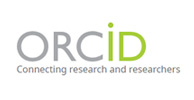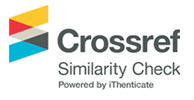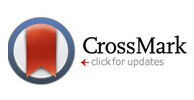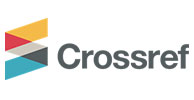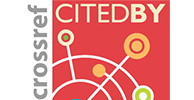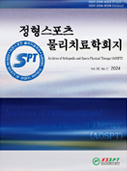
Journal Abbreviation : Korean Soc. Sport Phys. Ther.
Frequency : semiannual
Doi Prefix : 10.24332/aospt
Year of Launching : 2005
Publisher : The Korean Society of Sports Physical Therapy
Aims & scope more
The Korean Society of Sports Physical Therapy (KSSPT) has consistently been leading trends in the field of sports physical therapy by conducting educational programs for academia within and outside Korea with the aim of ensuring academic journals are of high quality. The Archives of Orthopedic and Sports Physical Therapy (AOSPT) is a journal released by the KSSPT and its main goal is to publish studies related to sports physical therapy and sports science that are based on recent scientific evidence. Studies published in the AOSPT must engage with creative topics to ultimately contribute to the development of rehabilitation medicine and physical therapy. The AOSPT focuses on fields related to sports physical therapy, medicine, and rehabilitation. The chief editor designates an editor to each research field corresponding to their areas of specialization which are as follows:
Ⅰ. Classification of studies
Studies are classified into original document, review, case report, and briefing. Publication decisions are made by the editorial board.
Ⅱ. Research ethics and compliance
1. All studies submitted to the AOPST must comply with the research ethics regulations.
2. All authors must be well acquainted with the research ethics regulations before submitting their articles.
3. Articles containing similar or identical content as those submitted to the AOPCT cannot be published in other journals. Authors must act in accordance with the regulations of the Institutional Review Board and are subjected to investigation upon any discoveries or reports of their violation.
4. If the author is found to have violated the research ethics regulations, the chief editor will forcibly cease reviewing the article or withdraw the article from publication.
Ⅲ. Language used
1. Studies submitted to the AOPST must be written in Korean or English.
Ⅳ. Studies submission and publication schedule
1. Studies are published at least twice a year.
2. Studies can be submitted to the AOPST at any time through the online submission system.
3. The chief editor must select a reviewer for each field of research and request a review within 10 days of the submission date, after sufficient discussion with the members of the editorial board.
4. A reviewer must complete reviewing a study within 15 days of receiving the review request.
5. The chief editor must inform the author of the review results within two months of the submission date.
6. The chief editor must record the submission date, review date, and confirmed publication date for each study before publication.
7. After publication is confirmed, a set of studies are gathered and published.
Ⅴ. Screening
1. The chief editor must select one editor and two reviewers who are specialized in the field of research corresponding to the article to be submitted. The chief editor must base his selection on the personal research achievements of the editor or reviewer.
2. The chief editor and editors of the AOPST must prevent exposure of personal information between authors and reviewers and must also prevent information leakage. Therefore, the chief editor must only send a manuscript to a reviewer after all the information regarding the author’s name and affiliation has been deleted. If information is mutually exposed or leaked between the author and reviewer, the chief editor must change the reviewer.
3. A reviewer must summarize the content of the manuscript they review in order to demonstrate to the author that they have a sufficient understanding of the manuscript’s content. If complaints arise from the author regarding the review results, the chief editor and editors in the corresponding field of research must decide whether the manuscript needs to be reviewed again based on the summary of the manuscript written by the reviewer.
4. A reviewer must objectively score articles according to the evaluation checklist developed by the AOPST.
5. For the sake of improving the overall research skills in academia, a reviewer has the basic responsibility to revise manuscripts and report the revisions in full detail.
6. A reviewer makes the final publication decision based on the VI-4 score and VI-5 revisions and sends the paper to the chief editor.
7. The chief editor determines whether the paper can be published or not. They also determine if the paper should be published after revisions and if the paper needs to be reviewed after these revisions..
Ⅵ. Submission preparation
Ⅰ. Manuscript preparation
2) Manuscripts must be written with a word processor program (Microsoft Word or Hangul). The title page, abstract, introduction, methods, results, discussion, references, tables, and figures must each be written on a new page in the stated order.
3) The following basic format must be used for all text within the manuscript:
(2) Text: Font (Times New Roman in Word and Malgun Gothic in Hangul), font size (10 pt), and line spacing (1.5 lines in Word and 300% in Hangul).
(3) Paragraph: The first line of a body paragraph must be indented at 1.27cm. Use a hanging indent of 1.27cm starting from the second line for references.
(4) Alignment: The title and subtitles (methods, results, discussion, and references) must be centered. The rest must be aligned to the left.
(2) Cite works in the styles shown below depending on the number of authors to be mentioned.
- “...라고 보고하였다(홍성현, 김인태, & 이진수, 2006).”
- “...was reported (Mather, Knight, & McGill, 2006).”
- “홍성현, 김인태, & 이진수(2006)는”
- “Mather, Knight, & McGill (2006) reported that…”
② Works with four or more authors.
- “...라고 보고하였다(홍길동 등, 2006).”
- “...was reported (Mather et al., 2006).”
- “홍성현 등(2006)은”
- “Mather et al. (2006) reported that…”
- “...을 보고하였다(김인태, 2006; 김인태 등, 2007; 홍성현, 김인태, & 이진수, 2006; Mather & Knight, 2006).”
2. Title page
(2) A subtitle is written after the main title with a colon (:) inserted between them.
4) Conflict of interest: Note if the research results were associated with benefits or losses to other people.
3. Abstract
2) The content of the abstract must match that of the manuscript.
3) Clearly outline the purpose, methods, results, and conclusions as well as provide the key data.
4) Write “Keywords” in italics below the abstract; however, do not write the actual keywords to be listed in italics. In English, write at least three keywords related to the paper’s topic. Each keyword must be separated by a comma (,) and be written in lower case.
4. Introduction
2) Center the title and align the main text to the left. Do not write the subheadings (“Introduction”).
5. Research method
2) For research involving human subjects, explain the process of handing out and receiving consent forms from the study’s participants.
3) Provide descriptions of the equipment used in the research in the following style:
(2) Product names and manufacturers can be written in Korean or English depending on the language used by the manufacturing company. Country must be written in Korean.
6. Results
2) The included tables or figures should not reiterate the contents of the body paragraphs.
7. Discussion
2) Compare the results to those in previous literature and explain what led to the current results being obtained. Avoid including information from textbooks that are not related to the research purpose.
3) In the final paragraph of the discussion section, summarize the main information related to the questions and answers informing the conclusion of the research.
8. References
2) List Korean literature first, followed by foreign literature. The order should be 가-나-다 and A-B-C. For works by the same author, list the works in the order of their publication beginning with the earliest work. Only list the works cited in the paper.
3) Follow the style shown in the examples below. When there are more than two authors, insert “&” before the name of the last author. If there are more than seven authors, write the names of the first five authors followed by “…” and the name of the last author.
김영남 (2000). 치위생과 학생이 임상실습 시 경험하는 스트레스 요인에 관한 연구, 경복대학논총. 4, 373-391.
백창무, 채수인, & 김정구 (2012). 방사선(학)과 학생 임상실습에 따른 스트레스. 대한영상의학회지, 6, 291-298.
이숙자 (1980). 간호학생의 임상실습 만족도에 관한 연구. 대한간호학회지, 10, 41-52.
이승주, & 박윤기 (1993). 물리치료과 학생들의 임상실습에 대한 태도조사. 대한물리치료학회지, 5, 25-37.
조남옥, 신현철, 김성우, 남희숙, 김성희, ...윤필성 (1998). 간호학생의 자기표현 수준과 임상 실습 스트레스와의 관계 연구. 한국간호교육학회지, 4, 317-330.
Anderson, A. K., Christoff, K., Panitz, D., De Rosa, E., & Gabrieli, J. D. E. (2003). Neural correlates of the automatic processing of threat facial signals. Journal of Neuroscience, 23, 5627-5633.
Calvo, M. G., & Lang, P. J. (2004). Gaze patterns when looking at emotional pictures: Motivationally biased attention. Motivation and Emotion, 28, 221–243.
Ro Ulrich, C., Billino, J., Sterzer, P., Weidauer, S., Bernhardt, T., ...Kleinschmidt, A. (2005). Effects of arousing emotional scenes on the distribution of visuospatial attention: Changes with aging and early subcortical vascular dementia. Journal of the Neurological Science, 229, 109–116.
이혁철 등. (2013). 스포츠 손상 및 재활(2판, 195-198). 한국:대학서림.
Chow, T. W., & Cummings, J. L. (2000). The amygdala and Alzheimer’s disease. In F. I. M. Craik & T. A. Salthouse (Eds.), The amygdala: A functional analysis (pp. 656–680). Oxford, England: Oxford University Press.
김석철 (2013). 등속성 장비를 활용한 재활 운동 프로그램이 프로 축구 선수의 근력 향상 및 경기 복귀 시기에 미치는 영향(석사학위, 한국대학교, 한국).
Adams, R. J. (2000). The amygdala and Alzheimer’s disease (Master’s thesis, Massachusetts Institute of Technology, USA).
9. Tables and figures
2) Maintain a resolution of at least 300 dpi for all figures.

